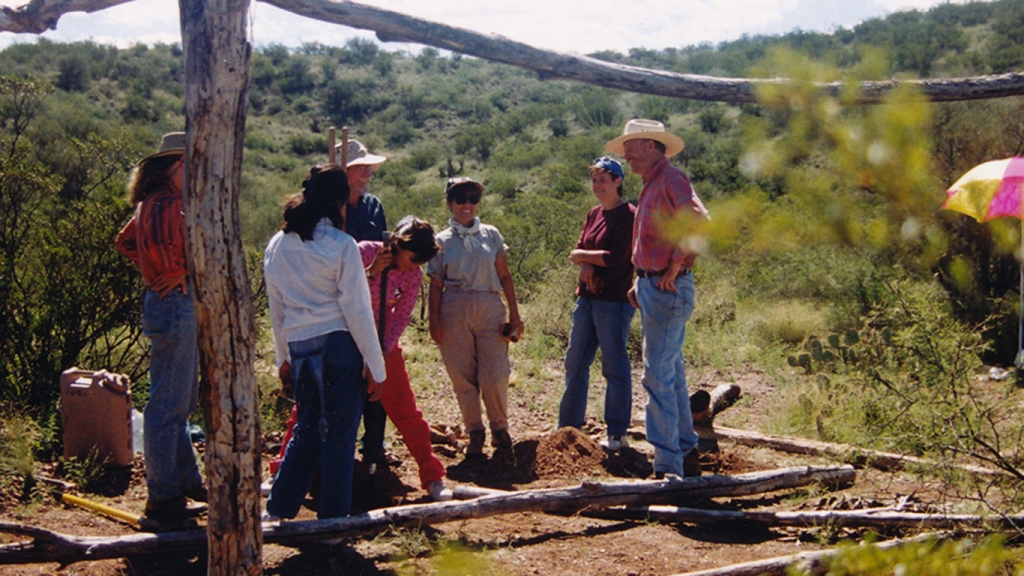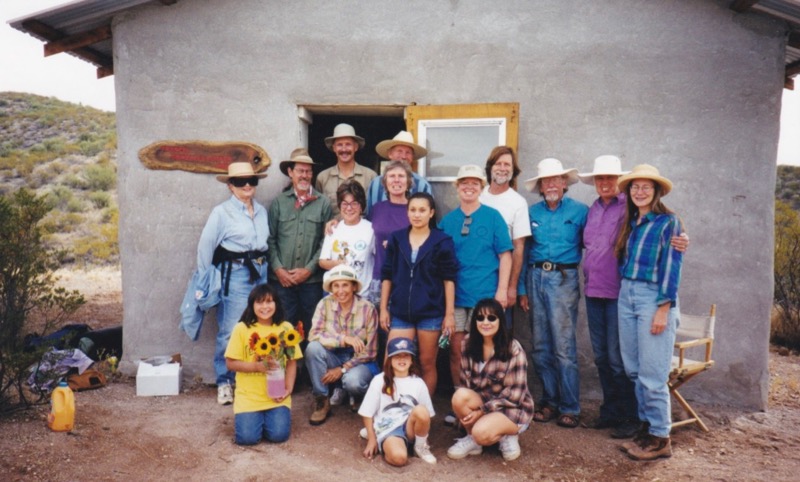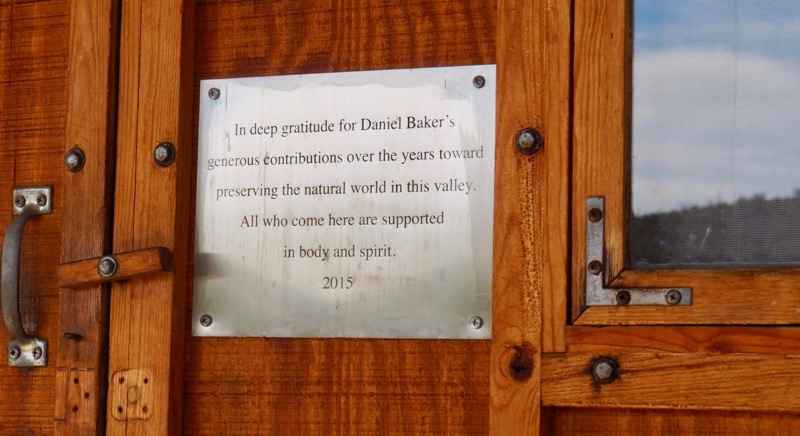Hermitage Program History
by Daniel Baker
The Cascabel Conservation Association hermitage program began with people who were ardent believers in the marriage of faith and action. In this case that faith was, from various religious and irreligious perspectives, a love for the land which came to be embodied in the association’s mission to “…promote the health, stability and diversity of the whole community, including its earth, waters, plants, and animals.” The hermitage program reflects that interdependence of communion with wild nature and the need to conserve it.
In 1994, prior to the domestic terrorist bombing in Oklahoma City, the militia movement was a growing phenomenon. Just such a group petitioned to purchase acreage for a firing range in Hot Springs Canyon that was being proffered by Cascabel Ranch Properties. The militia group’s representative made it clear that only humans (“two-leggeds”) would be their presumed target, with jeep-mounted machine guns as part of their firing range arsenal.
Cascabel is a small and very diverse community, but there were no vocal defenders of the militia petition, and many worried that such a group would attract an element less friendly to the community and the land. The Saguaro Juniper Corporation, which had purchased 135 acres of deeded land and a six-square-mile Arizona State Land grazing lease neighboring the proposal, was most alarmed. Many Saguaro-Juniper members had been active in the Tucson sanctuary movement, working to assist Central American refugees achieve their rightful legal status. After a high-profile trial in 1985-86, the sanctuary movement continued but with shifting roles. Some in the group turned part of their activism in the direction of land rights.
Jim and Pat Corbett were prominent in the sanctuary movement and, having a background in ranching, were advocates for Saguaro-Juniper’s purchase of the Hot Springs Canyon land and grazing lease. Jim had an ideal of a Maasai-like open-range pastoralism as a livelihood that could peacefully integrate with wildlands and permit conservation stewardship of large areas. In addition to his reputation as a leader in the sanctuary movement, his nationally-recognized book Goatwalking continued to draw attention.
With Saguaro-Juniper members leading the way, the Cascabel community put up a strong defense against the militia petition, and connections with the Cochise County Sheriff ultimately defeated it. Jim understood the ongoing nature of the threat to Saguaro-Juniper’s peaceful coexistence with the human and natural community and threw himself into a year-long search for a donor to help purchase and protect the neighboring land. He reached out to contacts, spoke in conferences, and wrote articles to promote the idea. Pat and Jim hosted interested people in their trailer home, discussing and showing the land.
Those benefactors eventually showed up in the persons of Francis Leitner and his wife, Mary Lou Gonzales. Francis happened on a “Friends Committee on Unity with Nature” article by Jim entitled, “It takes a community to change the world.” Francis was intrigued by the Saguaro-Juniper covenant of land rights, and in particular by Jim’s idea of establishing a hermitage allowing for concentrated communion with wildlands in semi-primitive conditions.
Francis was a self-described renegade Catholic who became enamored of Thomas Berry’s book, The Dream of the Earth, and what Berry called “The Great Work” on how we are to relate to the natural world. Along with Thomas Berry, Brian Swimme, and others, Francis came to believe in the importance of a new story of “…the universe and earth as modes of divine expression; of creation as the primary source of revelation.” Francis became convinced by Jim’s advocacy for saving the land from such life-threatening development and instead “…the use of the land as a place of solitude to nourish visions of creating the peaceable kingdom. …to provide a space where one can develop and feed their spirit through contact with the land [which] could possibly help avert the inevitable direction in which we are headed.” [from “The Great Work” by Francis Leitner in “Loaves and Fishes,” September-October, 1998, pp. 5-7].
Francis and Mary Lou made the enormously charitable gift of $100,000, representing much of their life’s savings and children’s inheritance, for the purchase of 400 of the threatened acres. In a show of solidarity, Saguaro-Juniper contributed funds for another 40 acres. Francis and Mary Lou needed a tax break on their gift, but that required a federally approved entity that could accept such a gift, which Saguaro-Juniper was not. A group of supporters came together to establish a non-profit organization which they called the Cascabel Hermitage Association. Francis and Mary Lou were joined on the board by their friend Shirley Pevarnik, as well as Sr. Elizabeth. From the Saguaro-Juniper group Jim Corbett, Meredith Little, Judith McBride, and Daniel Baker filled out the initial Cascabel Hermitage Association board of directors.

Going through the process of becoming a non-profit would take some time. Jim and Pat had strong ties with the Quaker’s Pima Meeting in Tucson, and Meredith, Judith, and Daniel were affiliated as well. Meredith began her long tenure with the association as its attorney and helped engineer the Pima Meeting Religious Society of Friends receiving the land and gaining the federal tax deduction until Cascabel Hermitage Association became recognized as a non-profit.
Following the difficult encounter with the militia group, Jim asked Fr. John Kane, Director of the Desert House of Prayer in Tucson, to bless the land. In May of 1995 Fr. Kane camped near the ruins in Hot Springs wash for five days and hiked daily to high points on the new CHA land. He had been active with the Tucson sanctuary movement, but spent his sojourn reading Thomas Merton’s journals. After his sojourn John said to Jim, “I have known you as an activist. Now I know you as a contemplative as well,” to which Jim replied, “They both go together, of course.”
Daniel Baker volunteered as a sort of administrator of the hermitage program. He had become acquainted with Jim and Pat on a Friends Service Committee trip in conjunction with the BorderLinks group. BorderLinks had strong ties to the Tucson sanctuary movement, so the trip, led by Kitty Ufford-Chase and Kate Bobrow (now Bobrow-Strain), stopped to visit the Corbetts in Cascabel. Daniel, who had a background both as a seminarian and businessman, was taken by Jim’s perspectives and the Saguaro-Juniper group and moved to Cascabel in the fall of 1994, just prior to the militia fiasco.
In order to protect an even larger block of threatened land and rejoin lands that had been subdivided by developers, Daniel purchased 160 acres that neighbored the hermitage association’s 440 acres in lower Hot Springs Canyon. This acreage included the “Old Windmill” property where Daniel established a camp which became the “Support Center” for the hermitage program. Jim, Daniel, and Judith met there with the Cochise County Assessor, Philip Leiendecker, in order to successfully gain property tax exclusion as a religious and conservation oriented non-profit.
Initially hermitage association sojourners merely camped on the land, but Francis and Mary Lou soon began work on the association’s first hermitage, a strawbale located almost two miles north of the windmill. They approved a remote site selected by Jim which had inspiring views of large swaths of the Middle San Pedro River Valley wildlands. Already elders, they worked assiduously on trenching and laying the foundation for the strawbale. Francis wrote eloquently about the difference between his “head knowledge” about the land and the physical reality of working in the heat of the Sonoran Desert.
The fortunes of the association gained tremendously when David Omick and Pearl Mast moved to Cascabel in 1996 and became volunteers and prime movers in the more pragmatic aspects of the hermitage program. They had worked with a Catholic community on the border in southern Texas and had considerable history in designing and living with low-tech alternatives that integrated well with the natural world. Shortly after arriving they built a moveable cottage on Saguaro-Juniper land across Hot Springs Wash from Daniel’s camp, sharing the old windmill as a water source.
As younger people with a commitment to simple, land-integrated living, David and Pearl’s donation to the association in labor and friendliness was remarkable. David led volunteers in the bale-raising, roofing, and finishing of the Francis Gonzales-Leitner Hermitage hermitage. He also designed and led volunteers in the construction of the “Tent-Ramada” hermitage situated on a ridge above lower Hot Springs Canyon and accessible only by foot. A third hermitage of David’s design, also accessible only on foot, was constructed as a simple ramada on another ridge near the middle of the hermitage land.

The Tent-Ramada and the Francis Gonzales-Leitner Hermitage served hundreds of sojourners from the year 2000 until 2012 and 2015 respectively. Sojourners were of all ages and varied locales, though often laborers in areas of social justice. Small groups, such as the Presbyterian Young Adult Volunteers and Proctor Academy, also used hermitage land for solo retreats on a yearly basis. Daniel was the main administrator of the hermitage program, but sojourners were also likely to be treated with a visit to David and Pearl’s off-grid homestead and Pearl’s mesquite pancakes.
During those years, ongoing threats to the land similar to the militia group’s continued to escalate in other guises. There was a growing recognition among associates of the ecological importance of the Hot Springs Canyon wildlife corridor and that the hermitage program’s ideal of solitude in wildlands remained vulnerable to injurious development. This led to a conservation project on surrounding properties in the canyon culminating in about 1800 acres of conservation easements being contracted between The Nature Conservancy and five landowners, including the Cascabel Hermitage Association’s holdings. Larger, valley-wide threats also loomed in a proposed Interstate-10 bypass and an enormous SunZia powerline corridor that would run through the heart of the valley.
Association membership and volunteerism continued to grow in concert with the hermitage program, and more associates became involved in combatting these efforts that would be injurious to the health, stability and diversity of the whole community, and the last-of-its-kind San Pedro River Valley environment. Furthermore, efforts at making the community more self-sustaining continued to expand the community garden and orchard programs.
In 2012, with the acquisition of the 130-acre “Baicatcan” property and a secure garden site, growth in these other programs led the association to reorganize as the Cascabel Conservation Association in recognition of its wider scope of effort. Consequently, the hermitage program evolved from being primarily led by Daniel, David, and Pearl to gaining wider involvement and support from others. At the same time, Daniel’s ability to serve the hermitage program was declining, so he donated the 160 acres that he’d purchased in Saguaro-Juniper shares to the Cascabel Conservation Association along with the funds to construct a hermitage at the old windmill. David and Pearl refitted and moved their original cottage there with off-grid amenities, and it was renamed the Corbett Retreat and Research Center.
It was at this time that the hermitage program once again benefited immeasurably with the arrival of Susan Tollefson. Susan, with a background in social service in Thailand and on the border in Juárez, México, took over administration of the hermitage program. The challenges and complexities of laboring with others for a more just and equitable world convinced her of the necessity for solitude and contemplation if actions are to be fruitful. Her decision to serve the Hermitage Program was also based on its commitment to a “donation” model which fosters stewardship of the earth and makes it available to anyone.
From her simple off-grid hermitage in Hot Springs Canyon she continues to host sojourners at the Corbett Center and manages maintenance of the site. Funds have recently been allocated for building a remote ramada and for further upgrades at the Corbett Center. Several other associates volunteer along with Susan, and they always welcome more.
Since 1995 the hermitage program has served hundreds of sojourners from all walks of life, though many have been peace- and social-justice activists. Retreats have extended from overnight to forty days and nights in duration, with five days being about average. Sojourner reflections have been unanimously positive, and some have indicated that it was a life-changing experience. In addition to personal benefits, the program has served to educate about the environmental riches of the middle San Pedro River Valley and helped recruit new members to the association.
The story of CCA’s hermitage program is one of people giving their lives and resources in the service of providing a semi-primitive experience of Sonoran Desert wildlands. That service is inspired by a faith in the sacredness of the earth and the importance of our relationship to it, both for the sake of the human and natural community’s survival as well as a deeper understanding of our integrated humanness. The story beneath that story resides in the land and its impact on the hearts, minds, and lives of the people experiencing it.

About | Facilities | Prepare to Sojourn | Sojourn Application | History
Header: Laurie Melrood / Building the Sukkah: Laurie Melrood / Group photo: photographer unknown / Plaque: Sue Newman
